Why did I call it curious? Because so many people have asked me what is it and what do they do with it? From the time of the success, studies reveal that in Mexico the chayote has been developed since pre-Columbian times and was presented while the 18th century into Europe then it was brought to Africa, Asia, and Australia.
The fruit, stems, young leaves, as well as the enlarged portions of the roots, are consumed as a vegetable. It can be consumed just plain steamed, or combined to stews and casseroles. So what is the chayote? It is a portion of the squash family. It is also committed as a "vegetable pear". In France, the chayote has named a christophene. The flesh is entirely crisp, maybe a little like the surface of the water chestnut. The
fruit and vegetable are usually green and shaped like a pear with soft skin that has pretty broad grooves running under the length of it. It is like a rough green pear.
The stems of the tree are stretchy and strong and have been applied in the production of baskets and hats.
In India, the fruit also roots are not only utilized as human food but also as animal food.
The fruit and especially the seeds are abundant in amino acids such as aspartic acid, glutamic acid, alanine, arginine, cysteine, phenylalanine, glycine, histidine, isoleucine, leucine, methionine (only in the fruit), proline, serine, tyrosine, threonine, and valine.
Portions of the chayote plant have been applied medicinally for a pretty long time - infusions (tea) made from the leaves are applied to terminate kidney stones and to support in the therapy of arteriosclerosis and hypertension. A mixture of
fruit and vegetable is applied to alleviate urine retention. The cardiovascular features of the mixture of leaves have been examined in recent researches, while their great effectiveness in curing kidney infections has been recognized since colonial times.
The head commercial generator and exporter of chayote fruit in Costa Rica, followed by Guatemala, Mexico, and the Dominican Republic. Chayotes have now become famous in the US and are discovered in numerous large markets. They are being cultivated in Florida, California, and Louisiana. Select firm, smooth, unwrinkled chayote, as old chayote becomes very wrinkled and hence dry and hard. Chayote will store refrigerated for many days but it is most beneficial to utilize it as soon as possible.
If you are considering growing you are personal, it is very easy to produce them and as you would have imagined we have an excellent environment for them. The Chayote likes a hot climate. It is complete in a sunny place where it can rise on a fence or something related, as it is a vine variety plant that requires assistance.
It is very simple to begin a plant. All you do is locate the chayote on a sunny window sill but not in direct sunlight, it will start to wrinkle and ultimately create a bud. The complete chayote with its unique bud is then stored in some soil but only partly surfaced, in a pot. Once the plant reveals it has become root it can be transferred to the outside and planted into the soil if you like. Water it daily.
The chayote can be consumed fresh in salads, stuffed, and baked. It can be mashed, pickled, fried, or boiled. Any recipe you have that requires for squash you can replace it with the local chayote.
Read More: 10 Dirty Fruits and Vegetables


